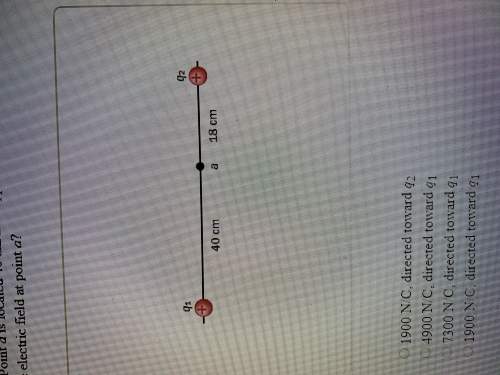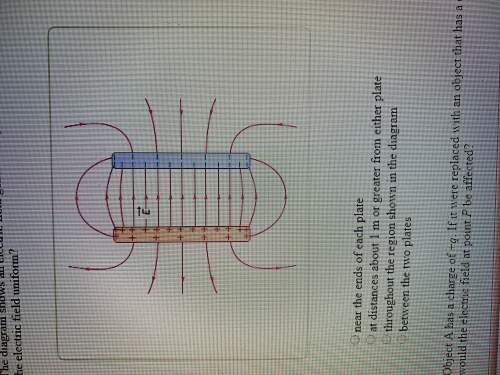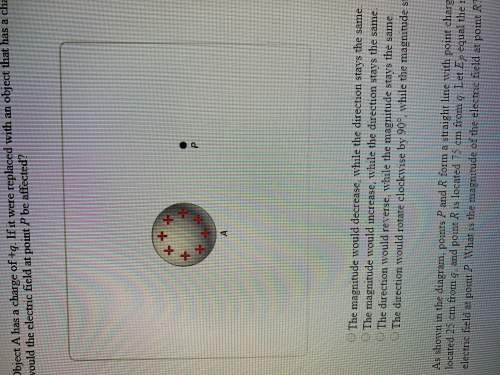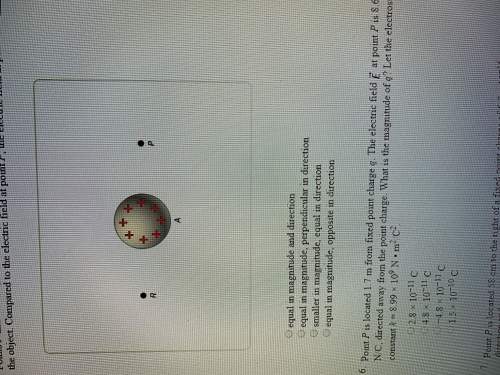
Physics, 13.01.2020 01:31 ayoismeisalex
1. point charges q 1 q 2 both of 22 nc are separated by a distance of 58 cm along a horizontal axis. point a is located 40 cm from and cm from q 1 q 2 . what is the magnitude and direction of the electric field at point a?
a)1900 n/c, directed toward q2
b)4900n / c , directed toward q1
c)7300 n/ c, directed toward q1
d)1900n / c , directed toward q 1
2. the diagram shows an electric field generated by two oppositely-charged flat plates. where is the electric field uniform?
a)near the ends of each plate
b)at distances about 1 m or greater from either plate
c)throughout the region shown in the diagram
d)between the two plates
3. object a has a charge of + q . if it were replaced with an object that has a charge of -q, how would the electric field at point p be affected?
a)the magnitude would decrease, while the direction stays the same.
b)the magnitude would increase, while the direction stays the same.
c)the direction would reverse, while the magnitude stays the same.
d)the direction would rotate clockwise by 90 degrees , while the magnitude stays the same
4. as shown in the diagram, points p and r form a straight line with point charge q. point p is located 25 cm from q, and point r is located 75 cm from q. let e p equal the magnitude of the electric field at point p. what is the magnitude of the electric field at point r?
a)ep/3
b)ep/9
c)ep/50
d)ep/25
5. points p and r are equidistant to charged object a, and they are positioned on opposite sides of (point) the object. compared to the electric field at point p theelectric field at point r is
a)equal in magnitude and direction
b)equal in magnitude, perpendicular in direction
c)smaller in magnitude, equal in direction
d)equal in magnitude, opposite in direction
6. point p is located 1.7 m from fixed point charge the electric field vec e at point p is 8.6 * 10 ^ (- 2) n/c, directed away from the point charge. what is the magnitude of q? let the electrostatic constant k=8.99*10^ 9 n* m^ 2 / c^ 2
a)2.8 x 10^-11 c
b)4.8 x 10^-11 c
c)-4.8 x 10-11 c
d)1.5 x 10 ^-10 c
7. point p is located 58 cm to the right of a fixed point charge of 6.7*10^ -16 c. what is the direction and magnitude of the electric field at point p due to this charge? let the electrostat constant k = 8.99 * 10 ^ 9 * n * m ^ 2 / (c ^ 2)
8.8 * 10 ^ (- 5) * n/c, to the right
2.4 * 10 ^ (- 6) * n/c , to the left
1.2*10^ (-5) * n/c, to the left
1.8*10^ (-5) n/c, to the right
8. a van de graaff generator causes a total charge q to build up on a metal sphere of radius which variable does not affect the electric field at a distance r from the center of the metal sphere? assume r> r
a)the distance r from the center of the metal sphere
b)the magnitude of the charge q
c)the radius r of the metal sphere
d)the sign of the charge q
9. a scientist fixes a test charge q’ to point p and then measures the electrostatic force it experiences there. she then calculates the magnitude of the electric field by applying the equation vec e = vecf^prime/vec q^prime. which change to her procedure would vary the value of vec e that she calculates?
a)keep the test charge in the same location, but alter its charge from q^prime to -q^1.
b)keep the charge on the test charge the same, but move the test charge to a different position farther away.
c)keep the test charge in the same location, but after its charge from q^prime to 2q^prime
10. q 1 q 2 point charge of 30 nc is separated by 50 cm from point charge q2 of -45nc. as shown in the diagram, point a is located 30 cm from q1 and 20 cm from q2. what are the magnitude and direction of the electric field at point a? let the electrostatic constant k = 8.99 * 10 ^ 9 * n m ^ 2 / (c ^ 2)
a)7000 n/c, directed to q2
b)13,000 n/c, directed to q1
c)13,000 n/c, directed to q2
d)7000 n/c, directed to q1






Answers: 1


Another question on Physics

Physics, 21.06.2019 16:40
Aforce of 34.5 newtons is applied to an object at an angle of 45 º with the horizontal. what is the force acting on the object in the horizontal direction?
Answers: 2

Physics, 21.06.2019 19:30
The lights used by mark watley (played by matt damon) during the film the martian seem to be metal halide lamps. metal halide lamps are filled with vaporized mercury and metal-halogen compounds. when an electric current is passed through the lamp, the tube begins to glow a bright white/blue color. if you were to pass this light through a prism to separate the individual light frequencies, you would see a rainbow just as you would if using natural sunlight because of the complexity of the metal halide gas and the vast amount of possible electron transitions. (the study of light in this way is known as spectroscopy and allows astronomers to know exactly what atoms compose distant stars, simply by looking at the light they emit. the spectral lines an atom produces uniquely identifies that atom just like a fingerprint uniquely identifies a person. the momentum equation and energy equation that we have used above can be combined to give the following equation: c = e p where again p is the phonon momentum, e is the photon energy and c is the speed of light. when you divide the photon energy found in #6 by the photon momentum found in #4, do you get the speed of light? (if not, check your work for questions #4 through #6). yes no
Answers: 2

Physics, 21.06.2019 22:30
Follow these directions and answer the questions. 1. shine a pencil-thin beam of light on a mirror perpendicular to its surface. (if you don't have a laser light as suggested in the video, you can make a narrow beam from a flashlight by making a cone from black construction paper and taping it over the face of the flashlight.) how does the light reflect? how does the relationship of incident to reflected ray relate to the reflection of water waves moving perpendicular to a barrier? 2. shine a pencil-thin beam of light on a mirror standing on a sheet of paper on the table (or floor) so that you can mark the incident ray and reflected ray. (you can support the mirror from the back by taping it to a wooden block.) 3. mark a line on the paper representing the reflective surface. (the reflective surface of a mirror is usually the back edge.) 4. draw a dashed line perpendicular to the mirror surface at a point where the incident and reflected ray meet. this perpendicular is called a normal to the surface. 5. measure the angles between the rays and the normal. the angle of incidence is the angle formed by the incident ray and the normal to the surface. the angle formed by the reflected ray and normal is called the angle of reflection (r). what is the angle of incidence? what is the angle of reflection? 6. repeat for several different angles. (see report sheet for details.) what appears to be the relationship between the angle of incidence and angle of reflection? in science 1204, what was the relationship for these two angles made by the reflection of waves in a ripple tank? 7. roll a ball bearing so that it hits a fixed, hard surface (a metal plate) at several angles (including head-on). observe the way in which the ball bearing reflects. what generalization can you make about how a ball bearing reflects from a wall? have you proved that light can only behave like a wave?
Answers: 1

Physics, 22.06.2019 17:00
Amajor difference radio waves, visible light, and gamma rays is the of the photons, which results in different photon frequencies and wavelengths
Answers: 1
You know the right answer?
1. point charges q 1 q 2 both of 22 nc are separated by a distance of 58 cm along a horizontal axis....
Questions



English, 17.04.2020 18:42





Mathematics, 17.04.2020 18:42

Biology, 17.04.2020 18:42





Biology, 17.04.2020 18:42

English, 17.04.2020 18:42


Mathematics, 17.04.2020 18:42

Mathematics, 17.04.2020 18:42


Mathematics, 17.04.2020 18:42



